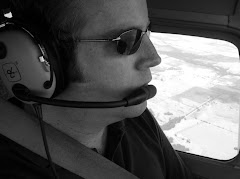
Lots going on here, but nothing that would make for solid copy. Mostly book learnin' and studying up for our written instrument test, which should be in the next few days. Checkride in about two weeks. And my instructor Troy is getting hitched this weekend, so we got subs for a few days.
Went up yesterday afternoon to practice approaches and holds after a disastrous morning session in the sim* which rattled my confidence. The flight went great... shot a VOR-DME approach and a GPS approach (the Seminoles all have dual Garmin GNS 430s, by the way) at Corsicana which both went good, then an ILS approach back into Arlington which was damn near perfect. Feeling great about my progress.
--
Nearly everyday I read the online version of my hometown paper, uniontrib.com, and today they reminded me of the 30th anniversary of the crash of PSA flight 182. Sorry to wax sentimental about such a morose topic, especially on a blog that's meant to spin aviation as a wonderful pursuit, but it's weighing on my mind. Christ... 30 years.
I was a second-grader at Francis Parker School on September 25th, 1978 when word came in before lunch that a plane had crashed in North Park and that a lot of people had died. A 7-year old doesn't have much concept of such things, but I knew that my sister Maggie lived in North Park, so I got pretty scared until I discovered upon returning home that she was okay. Ever since, I've been fascinated with that incident. As the years went on and I matured along with the historical significance, I realized just how much PSA and that crash meant to San Diego (its headquarters).
In fact, my first memory of flying was on a PSA plane, on a night flight as a toddler (from L.A. to San Diego, Mom reminds me). One of their famously gorgeous stewardesses asked me if I wanted some ice cream. Presumably with Mom's approval, she led me by the hand up to the galley and helped me make a sundae... fudge, nuts, whipped cream, everything... in a glass bowl! Try getting that kind of service on a 10-hour flight these days, much less a 40-minute hop.
30 years!
Events like these are a reality that pilots and passengers face, but from them is born new technology that keeps us all pretty safe, and I, for one, am quite grateful for it.
* thanks for reminding me... it's technically a "flight training device", not a simulator. I wish sarcastic inflection was an option in written form.
 We have three of these at Arlington. It my not look like a whole lot, but has features that make it remarkably close to flying the Seminole. In fact, controlling this thing is a bitch... much tougher than the real thing, since the "outdoors" are only found immediately in front of the left seat and of course, the "seat of the pants" sensations are missing. Still a pretty good trainer, though. We're getting to know each other quite well...
We have three of these at Arlington. It my not look like a whole lot, but has features that make it remarkably close to flying the Seminole. In fact, controlling this thing is a bitch... much tougher than the real thing, since the "outdoors" are only found immediately in front of the left seat and of course, the "seat of the pants" sensations are missing. Still a pretty good trainer, though. We're getting to know each other quite well...




